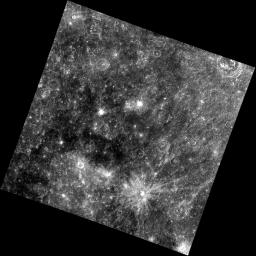The human eye is sensitive to light with wavelengths from about 400 to 700 nanometers (nm). We perceive light from the short-wavelength end of this spectrum as violet or indigo. Today's image was taken through a filter with a center wavelength of 433 nm, corresponding to these indigo colors. Named craters in the scene include Zeami, Rublev, and the Tolstoj basin.
This image was acquired as part of MDIS's 8-color base map. The 8-color base map is composed of WAC images taken through eight different narrow-band color filters and covers more than 99% of Mercury's surface with an average resolution of 1 kilometer/pixel. The highest-quality color images are obtained for Mercury's surface when both the spacecraft and the Sun are overhead, so these images typically are taken with viewing conditions of low incidence and emission angles.
Date acquired: December 17, 2011
Image Mission Elapsed Time (MET): 232625123
Image ID: 1148457
Instrument: Wide Angle Camera (WAC) of the Mercury Dual Imaging System (MDIS)
WAC filter: 6 (433 nanometers)
Center Latitude: -9.90°
Center Longitude: 201.7° E
Resolution: 863 meters/pixel
Scale: The scene is about 940 km (580 mi.) across
Incidence Angle: 27.3°
Emission Angle: 0.7°
Phase Angle: 28.0°
North is to the top right of the image
The MESSENGER spacecraft is the first ever to orbit the planet Mercury, and the spacecraft's seven scientific instruments and radio science investigation are unraveling the history and evolution of the Solar System's innermost planet. Visit the Why Mercury? section of this website to learn more about the key science questions that the MESSENGER mission is addressing. During the one-year primary mission, MDIS acquired 88,746 images and extensive other data sets. MESSENGER is now in a year-long extended mission, during which plans call for the acquisition of more than 80,000 additional images to support MESSENGER's science goals.
These images are from MESSENGER, a NASA Discovery mission to conduct the first orbital study of the innermost planet, Mercury. For information regarding the use of images, see the MESSENGER image use policy.

 Planetary Data System
Planetary Data System












